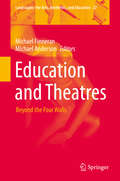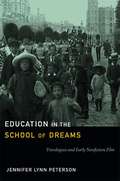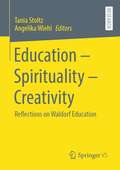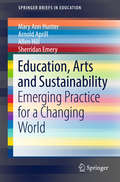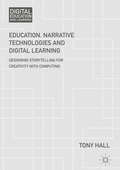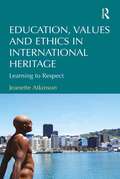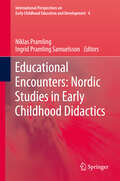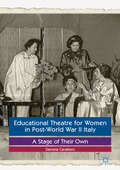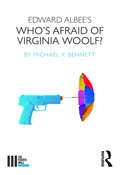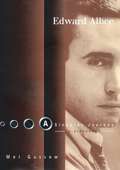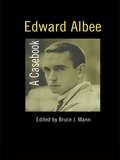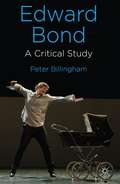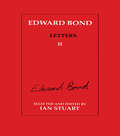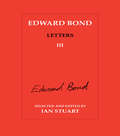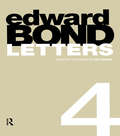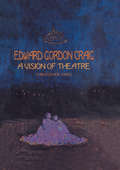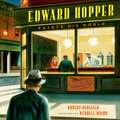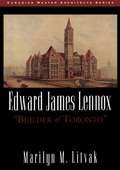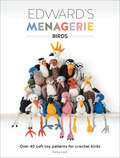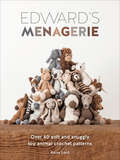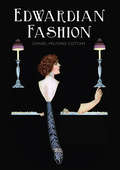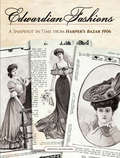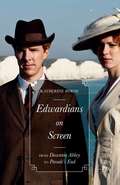- Table View
- List View
Education and Theatres: Beyond the Four Walls (Landscapes: the Arts, Aesthetics, and Education #27)
by Michael Anderson Michael FinneranThis volume is the first book to map a broad range of practices and critically examine the impact of education and outreach programmes in theatres and theatre companies around the globe.This innovative volume looks specifically at the manner in which theatres and theatre companies engage in educational, outreach and community work. An array of global case studies examines a wide range of existing and innovative practices, and scrutinises how this work achieves successful results and delivers impact and outcome on investment.The editors set the scene briefly in terms of the history of education in theatre organisations, and then move on to chart some of the difficulties and challenges associated with this work, as well as looking into the conceptual issues that need to be interrogated so that we may understand the impact of outreach and education work on the communities and audiences it aims to reach. A range of theatre practitioners and academics describe their work, its background, and what the authors understand to be successful outcomes for both the participants and the theatres. Finally, the book offers suggestions for both practitioners and researchers regarding further development in this work.
Education in Albuquerque
by Ann Piper Dr Ernie StapletonA mix of cultures unique to any space in North America funneled into the Albuquerque, New Mexico, area after Spanish invaders stumbled in through the south in 1506. For centuries, indigenous Americans had established ways of knowing and transmitting learning to their young, but colliding old and new cultures left the area's learning communities irrevocably changed. Subsequently, other native tribes and more European, South American, and Asian cultures proudly ported their perceived best practices concerning educating youth into the area. In 1880, the railroad, bolstered by powerful Anglo economic forces, blasted into Albuquerque, carrying new cultures clinging to the railcars: Greeks, Italians, Germans, Jews of many heritages, English, Easterners, Southerners, a host of cowboys, farmers, merchants, and more--all shadowed by motivated politicians. The founding, unfolding, and evolution of educational systems in Albuquerque weaves a crazy-quilt story regarding public, private, and parochial schooling--as well as regrettably ill-founded systems that wronged natives.
Education in the School of Dreams: Travelogues and Early Nonfiction Film
by Peterson Jennifer LynnIn the earliest years of cinema, travelogues were a staple of variety film programs in commercial motion picture theaters. These short films, also known as "scenics," depicted tourist destinations and exotic landscapes otherwise inaccessible to most viewers. Scenics were so popular that they were briefly touted as the future of film. But despite their pervasiveness during the early twentieth century, travelogues have been overlooked by film historians and critics. In Education in the School of Dreams, Jennifer Lynn Peterson recovers this lost archive. Through innovative readings of travelogues and other nonfiction films exhibited in the United States between 1907 and 1915, she offers fresh insights into the aesthetic and commercial history of early cinema and provides a new perspective on the intersection of American culture, imperialism, and modernity in the nickelodeon era. Peterson describes the travelogue's characteristic form and style and demonstrates how imperialist ideologies were realized and reshaped through the moving image. She argues that although educational films were intended to legitimate filmgoing for middle-class audiences, travelogues were not simply vehicles for elite ideology. As a form of instructive entertainment, these technological moving landscapes were both formulaic and also wondrous and dreamlike. Considering issues of spectatorship and affect, Peterson argues that scenics produced and disrupted viewers' complacency about their own place in the world.
Education – Spirituality – Creativity: Reflections on Waldorf Education
by Tania Stoltz Angelika WiehlEducation, spirituality and creativity help to navigate possible courses of action, in a life marked by commercialization and loss of meaning. Education that promotes knowledge and managing information while neglecting autonomous cognition and creative action can be found everywhere. On the other hand, education, spirituality and creativity are essential for a life led with awareness, empathy and criticism that are reflected upon in the present anthology by authors from Brazil and Europe. They inspire new educational approaches and encourage immersing oneself in undefined and uncertain phenomena.The Editors
Education, Arts and Sustainability: Emerging Practice For A Changing World (SpringerBriefs in Education)
by Arnold Aprill Mary Ann Hunter Allen Hill Sherridan EmeryThis book addresses this challenge by proposing an integration of sustainability and arts education in both principle and practice. In a global context of intensifying social, economic and environmental crises, education is key to raising awareness and motivating individuals and communities to act in sustaining life in our more-than-human world. But how is this done when the complexity and need for change becomes overwhelming, and schooling systems become complicit in supporting the status quo?Drawing on critical education theory and precepts of creativity, curiosity and change, it documents a series of case examples that demonstrate how five principles of Education for Sustainability - critical thinking, systems thinking, community partnership, participation, and envisioning better futures - are found at the heart of much arts practice in schools. Featuring the creative work and voices of teachers working in arts-based enquiry and diverse community-engaged contexts, the book investigates how sustainability principles are embedded in contemporary arts education thinking and pedagogy. The authors are unapologetically optimistic in forming an alliance of arts and sustainability education as a creative response to the challenge of our times, arguing that while they may have operated on the margins of conventional pedagogy and curriculum, they have more than marginal impact.
Education, Narrative Technologies and Digital Learning: Designing Storytelling for Creativity with Computing (Digital Education and Learning)
by Tony HallThis book examines and illustrates the potential of narrative technology, the integration and synthesis of storytelling and digital media in education. Storytelling is a foundational and powerful process in all learning and teaching, and technology is becoming ever more ubiquitous and sophisticated, particularly in its capabilities to mediate and augment creative storytelling. The book begins with a foundational analysis of narrative use in education today, and provides a history of the emergence of narrative technology. It explores how the convergence of high-potential computing and storytelling practices and techniques can be used to enhance education, in particular the design of bespoke, interactive physical learning environments. The contemporary importance of educational design is highlighted throughout the book, which concludes with the SCÉAL design-based research framework as a proposed systematic approach to the design of narrative technology in education. The book will be a valuable resource for educational designers, technologists, teachers and policymakers, especially those with an interest in the design and use of narrative technology in education.
Education, Values and Ethics in International Heritage: Learning to Respect
by Jeanette AtkinsonThe changing and evolving relationship between museums and communities, Indigenous, ethnic and marginalized, has been a primary point of discussion in the heritage sector in recent years. Questions of official and unofficial heritage, whose artefacts to collect and exhibit and why, have informed and influenced museum practice. Developing from this, a key issue is whether it is possible to raise awareness of differing cultural perspectives, values and beliefs and incorporate this into the education and training of heritage professionals, with the aim of making 'cultural awareness' an integrated and sustainable core part of future heritage training and practice. This book discusses perceptions of values and ethics, authenticity and significance, and documents the historical, heritage and education context in North America, Scandinavia and the United Kingdom, with a particular emphasis on Aotearoa New Zealand. The author explores whether it is possible to learn respect for differing cultural perspectives through the undertaking of educational programmes, identifies various approaches that could complement the development of students and professionals in the cultural heritage and preservation sectors, and offers a means of actively engaging with cultural and professional values through a Taxonomy for Respecting Heritage and Values.
Educational Encounters: Nordic Studies in Early Childhood Didactics
by Ingrid Pramling Samuelsson Niklas PramlingQualitative analyses of young children's learning in natural settings are rare, so this new book will make educators sit up and pay attention. It lays out a Nordic, or continental European teaching and learning paradigm whose didactic framework is distinct from the Anglo-American system. This analysis, which features contributions and case studies from researchers in a range of subjects, is built on principles such as the learner's perspective, establishing sufficient intersubjectivity, 'pointing out', and informing experience linguistically. After clarifying some historical background, the book discusses the contemporary emphasis in early childhood education on pedagogy/learning. What should 'didactics' mean in educating young children? The book examines the opportunities for learning that teachers provide for children in early childhood education, as well as how children respond to these opportunities. It presents empirical studies from a variety of naturalistic settings, including mathematics, making visual art, ecology, music, dance, literacy and story-telling, as well as learning about gender, morality and democracy. The authors seek to answer key questions about the processes involved in both teaching and learning. What challenges do teachers face as they try to expand children's knowledge in various fields of learning? How do they respond to these challenges, and what can we learn about children's corresponding uptake? What now requires further research? One key distinction in researching children's learning is between studies that look at 'process' and those that analyze 'product'. In the tradition of Piaget, Vygotsky and Werner, as well as Mercer and Valsiner's more recent work, this book advocates the importance and relative rareness of the former type of study.
Educational Theatre for Women in Post-World War II Italy
by Daniela CavallaroThis book explores an important moment in Italian women's theatre and cultural history: plays written for all-women casts between 1946 and the mid-1960s, authored for the most part by women and performed exclusively by women. Because they featured only female roles, they concentrated on aspects of specifically women's experience, be it their spirituality, their future lives as wives and mothers, their present lives as workers or students, or their relationships with friends, sisters and mothers. Most often performed in a Catholic environment, they were meant to both entertain and educate, reflecting the specific issues that both performers and spectators had to confront in the years between the end of the war and the beginning of the economic miracle. Drawing on material never before researched, Educational Theatre for Women in Post-World War II Italy: A Stage of Their Own recovers the life and works of forgotten women playwrights while also discussing the role models that educational theatre offered to the young Italian women coming of age in the post-war years.
Edward Albee's Who's Afraid of Virginia Woolf? (The Fourth Wall)
by Michael Y. BennettEdward Albee’s Who’s Afraid of Virginia Woolf? shocked audiences and critics alike with its assault on decorum. At base though, the play is simply a love story: an examination of a long-wedded life, filled with the hopes, dreams, disappointments, and pain that accompany the passing of many years together. While the ethos of the play is tragicomic, it is the anachronistic, melodramatic secret object—the nonexistent "son"—that upends the audience’s sense of theatrical normalcy. The mean and vulgar bile spewed among the characters hides these elements, making it feel like something entirely "new." As Michael Y. Bennett reveals, the play is the same emperor, just wearing new clothes. In short, it is straight out of the grand tradition of living room drama: Ibsen, Chekhov, Glaspell, Hellmann, O’Neill, Wilder, Miller, Williams, and Albee.
Edward Albee: A Biography
by Mel GussowIn 1960, Edward Albee electrified the theater world with the American premiere of The Zoo Story, and followed it two years later with his extraordinary first Broadway play, Who's Afraid of Virginia Woolf? Proclaimed as the playwright of his generation, he went on to win three Pulitzer Prizes for his searing and innovative plays. Mel Gussow, author, critic, and cultural writer for The New York Times, has known Albee and followed his career since its inception, and in this fascinating biography he creates a compelling firsthand portrait of a complex genius.The book describes Albee's life as the adopted child of rich, unloving parents and covers the highs and lows of his career. A core myth of Albee's life, perpetuated by the playwright, is that The Zoo Story was his first play, written as a thirtieth birthday present to himself. As Gussow relates, Albee has been writing since adolescence, and through close analysis the author traces the genesis of Who's Afraid of Virginia Woolf?, Tiny Alice, A Delicate Balance, and other plays. After his early triumphs, Albee endured years of critical neglect and public disfavor. Overcoming artistic and personal difficulties, he returned in 1994 with Three Tall Women. In this prizewinning play he came to terms with the towering figure of his mother, the woman who dominated so much of his early life.With frankness and critical acumen, and drawing on extensive conversations with the playwright, Gussow offers fresh insights into Albee's life. At the same time he provides vivid portraits of Albee's relationships with the people who have been closest to him, including William Flanagan (his first mentor), Thornton Wilder, Richard Barr, John Steinbeck, Alan Schneider, John Gielgud, and his leading ladies, Uta Hagen, Colleen Dewhurst, Irene Worth, Myra Carter, Elaine Stritch, Marian Seldes, and Maggie Smith. And then there are, most famously, Elizabeth Taylor and Richard Burton, who starred in Mike Nichols's acclaimed film version of Who's Afraid of Virginia Woolf? The book places Albee in context as a playwright who inspired writers as diverse as John Guare and Sam Shepard, and as a teacher and champion of human rights.Edward Albee: A Singular Journey is rich with colorful details about this uniquely American life. It also contains previously unpublished photographs and letters from and to Albee. It is the essential book about one of the major artists of the American theater.
Edward Albee: A Casebook (Casebooks on Modern Dramatists #Vol. 29)
by Bruce MannFrom the "angry young man" who wrote Who's Afraid of Virginia Woolf in 1962, determined to expose the emptiness of American experience to Tiny Alice which reveals his indebtedness to Samuel Beckett and Eugene Ionesco's Theatre of the Absurd, Edward Albee's varied work makes it difficult to label him precisely. Bruce Mann and his contributors approach Albee as an innovator in theatrical form, filling a critical gap in theatrical scholarship.
Edward Bond Letters: Volume 5 (Contemporary Theatre Studies #Vol. 14.)
by Ian StuartFirst Published in 1994. Edward Bond Letters, Volume V, contains over thirty letters and papers covering Bond's controversial views on violence and justice, plays, writers and directors, and a postscript that is Bond's discussion of the funeral of Diana, Princess of Wales. The explosive content of these letters applies to Bond's plays and society as a whole; Bond believes that all violence is the manifestation of an unbalanced and dangerous society. As with the four preceding volumes in this collection, Edward Bond is critical of present theatre, but at the same time his observations are useful in indicating how theatre can be changed. Bond's illustrations provide accompaniment to the letters.
Edward Bond: A Critical Study
by Peter BillinghamThis new study of one of Britain's greatest modern playwrights represents the first major, extended discussion of Edward Bond's work in over twenty years. The book combines rigorous and stimulating analysis and discussion of Bond's plays and ideas about drama and society. For the first time, there is also discussion of selected plays from his later, post-2000 period, including Innocence and Have I None, alongside explorations of widely studied plays such as Saved.
Edward Bond: Letters 2
by Ian StuartFirst Published in 1996. Routledge is an imprint of Taylor & Francis, an informa company.
Edward Bond: Letters 3
by Ian StuartFirst Published in 1997. Routledge is an imprint of Taylor & Francis, an informa company.
Edward Bond: Letters 4 (Contemporary Theatre Studies #Vol. 14.)
by Ian StuartEdward Bond Letters, Volume IV, focuses on four significant areas of Edward Bond's work: education, imagination and the child; theatre-in-education; At the Inland Sea; language and imagery. The letters represent a coruscating attack on our present society, as well as offering insights into how the situation might be improved. Bond's letters attack modern education, arguing that "children are being educated to sell themselves" and suggesting that social problems are caused by an oppression of the imagination. Many letters refer directly to a play - for instance Tuesday, which presents an assessment of the many difficulties faced by contemporary society. The language and imagery of one of Bond's most recent plays, In the Company of Men, is animatedly discussed, and Bond reminds us in a final description that "the good image is always absent, because it is present in the mind.
Edward Gordon Craig: A Vision of Theatre
by Christopher InnesEdward Gordon Craig's ideas regarding set and lighting have had an enormous impact on the development of the theatre we know today. In this new and updated edition of his well-known study of Edward Gordon Craig, Professor Christopher Innes shows how Craig's stage work and theoretical writings were crucial to the development of modern theatre. This book contains extensive documentation and re-evaluates his significance as an artist, actor, director and writer. Craig is placed in historical context, and his productions are reconstituted from unpublished prompt-books, sketches, journals and correspondence. Most of the designs and photographs, and many of Craig's writings cited, are not available elsewhere in print. Readers will gain insight into a key period of theatrical history, the life of one of its most fascinating individuals, the nature of stage performance, and into revolutionary ideas that are still challenging today.
Edward Hopper Paints His World
by Robert BurleighAs a boy, Edward Hopper knew exactly what he wanted to be when he grew up: on the cover of his pencil box, he wrote the words EDWARD HOPPER, WOULD-BE ARTIST. He traveled to New York and to Paris to hone his craft. And even though no one wanted to buy his paintings for a long time, he never stopped believing in his dream to be an artist. He was fascinated with painting light and shadow and his works explore this challenge. <P><P>Edward Hopper's story is one of courage, resilience, and determination. In this striking picture book biography, Robert Burleigh and Wendell Minor invite young readers into the world of a truly special American painter (most celebrated for his paintings "Nighthawks" and "Gas").
Edward James Lennox: "Builder of Toronto"
by Marilyn M. LitvakFrom 1876 to 1915, Edward James Lennox was a formidable force in Toronto’s architectural community. Many of his buildings are still landmarks in a city that continues to evolve.Born and educated in Toronto, Lennox looked to the past for inspiration but was never captured by it. His prototypical Annex houes on Madison Avenue, Old City Hall, and Casa Loma bear witness to his technical expertise and aesthetic sensibilities. Through text and illustrations, this volume tells the story of the a resolute architect whose vision helped shape an emerging city, and who in his time was called the "builder of Toronto."Edward James Lennox, "Builder of Toronto" is the first volume in the Canadian Master Architect series. Each publication will profile the work of an individual Canadian architect. The series editor is Marilyn M. Litvak.
Edward's Menagerie - Birds: Over 40 Soft Toy Patterns for Crochet Birds
by Kerry LordFeather Your Nest With These Lovable Crochet Birds!The eagerly awaited follow-up to the runaway bestseller Edward's Menagerie has arrived with BIRDS! Featuring 40 fine-feathered friends including a bashful Flamingo, romance-writing Owl, and playful Penguin, these unforgettable crochet birds are quick to make using supersoft yarn in playful color palettes. Their larger-than-life personalities will fly off your hook as you crochet them for all your friends and family!s into you!
Edward's Menagerie: Over 40 Soft and Snuggly Toy Animal Crochet Patterns (Edward's Menagerie Ser. #3)
by Kerry LordGet ready to spend some time with a suave high-flying rhino, a lovesick elephant who knows her way around a kitchen and a seriously chivalrous tiger . . .With just two weeks to go before baby Edward's due date, yarn enthusiast Kerry Lord picked up a crochet hook for the first time and a new obsession began. Over the next 12 months the collection of crochet animals expanded week on week until Edward's Menagerie was complete with 40 unique patterns.These cute animals with larger-than-life personalities are made using simple crochet techniques and the step-by-step instructions enable a complete beginner to get hooking straight away. Each animal also has a universal pattern where you can change your hook and yarn to create four different sizes, making 160 different possibilities.Be warned that these unlikely characters made using a supersoft yarn in a sumptuous natural colour palette will become your new best friends as you hook your way through the whole menagerie!
Edwardian Fashion
by Daniel CottamFashion in the Edwardian period underwent some quite revolutionary changes. The delicately coloured, flower-and-lace-trimmed trailing gowns and elaborate hairstyles worn by tightly corseted fashionable ladies in the early years of Edward VII's reign would transform into the boldly coloured, dramatically stylized Eastern-inspired kimono wraps, slender hobble skirts, ankle-skimming tunic dresses and turbans of 1914 on the eve of the First World War. This book presents the story of women's and men's dress through this exciting period, and is a fascinating addition to the bestselling Shire fashion list that already includes Fashion in the Time of Jane Austen and Fashion in the Time of the Great Gatsby.
Edwardian Fashions: A Snapshot in Time from Harper's Bazar 1906
by Kristina SeleshankoAlthough Edwardian-era clothing remains popular among fashion enthusiasts, there are very few books focusing on styles of the early 1900s. This compilation bridges that gap with dozens of authentic images from the period, selected from 1906 editions of Harper's Bazar. Since its first publication in 1867, the magazine has reflected contemporary styles and trends, and these illustrations — from spring hats and fancy aprons to French evening gowns and bridal attire — offer an intriguing reflection of American values at the turn of the twentieth century.The four-part collection begins with everyday fashions, including sweeping gowns for home, travel, and outdoors. A section of seasonal fashions features spring and summer ensembles, followed by an assortment of styles for weddings, the theater, and other special occasions. The final section, For the Young and Old, includes simple gowns for both ends of the age spectrum as well as graduation gowns. Costumers, fashion designers, and anyone interested in the history of style and couture will welcome this choice assembly of genuine Edwardian fashions.www.doverpublications.com
Edwardians on Screen: From Downton Abbey to Parade’s End
by Katherine ByrneThis book explores television's current fascination with the Edwardian era. By exploring popular period dramas such as Downton Abbey , it examines how the early twentieth century is represented on our screens, and what these shows tell us about class, gender and politics, both past and present.
